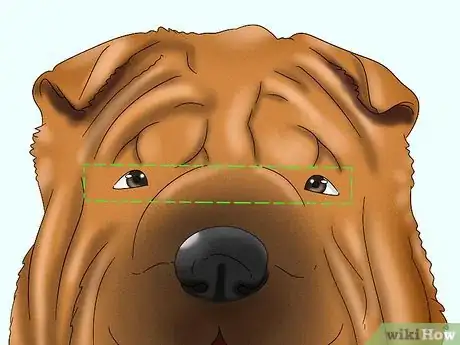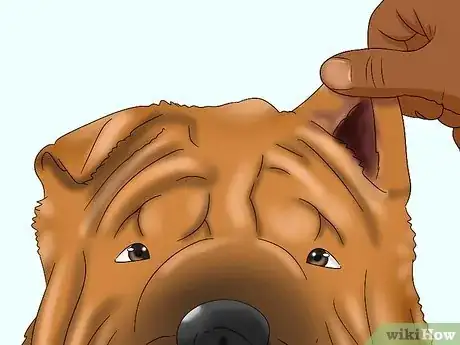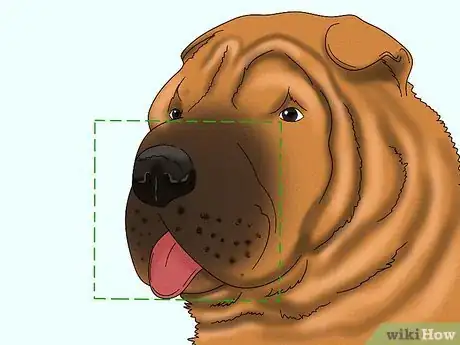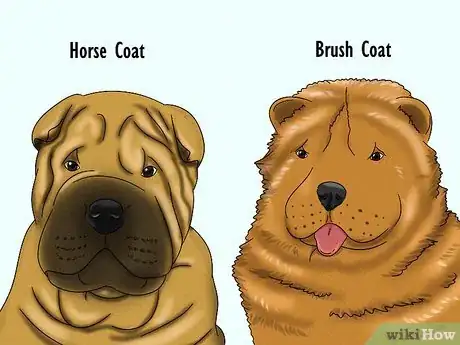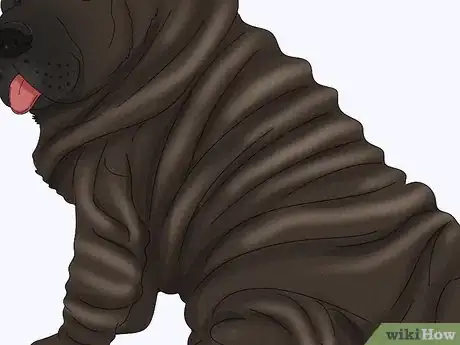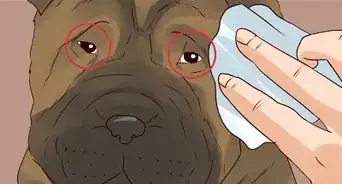wikiHow is a “wiki,” similar to Wikipedia, which means that many of our articles are co-written by multiple authors. To create this article, volunteer authors worked to edit and improve it over time.
This article has been viewed 8,869 times.
Learn more...
The Chinese Shar-Pei is an ancient Asian breed and a member of the non-sporting group.[1] Once used for their versatility by peasants and farmers in China, they are now guardians and companions.[2] With a name translating to "sand skin", Shar-Pei have quite the unique appearance, and if you're able to recognize the breed's distinct traits, you can get a better idea of whether or not a dog is a Shar-Pei.
Steps
Inspecting the Dog's Structure
-
1Pay attention to the size of the dog. Shar-Pei are medium-sized dogs and stand between 18 to 20 inches (46 to 51 cm) in height. They weigh 45–60 pounds (20–27 kg).[3]
-
2Check the eyes. The eyes of a Shar-Pei are noticeably sunken into the head and give the dog a scowling expression. They are dark, small, and almond-shaped.[4]Advertisement
-
3Look at the ears. A Shar-Pei's ears are extremely small and rather thick. They resemble equilateral triangles and are set high and lie flat against the head, the slightly rounded tips pointing forward toward the eyes and possibly curling.[5]
-
4Notice the muzzle. Shar-Pei have distinctive muzzles which are broad and full, being compared to that of a hippopotamus.[6] The nose is large and wide, the color preferably black, though other colors may be seen depending on the coat color of the dog, including self-colored or lightly pigmented noses.[7]
- Some people distinguish Shar-Pei by their muzzles and separate them into the groups of bone-mouth and meat-mouth dogs. Bone-mouth dogs have longer muzzles and are the original Shar-Pei breed, while meat-mouth dogs have the distinct, loosely-skinned, and flatter muzzles. Those that seem in-between the two types are sometimes called tweeners.[8]
-
5Spot a blue tongue. The tongue and mouth of a Shar-Pei is known for being a solid bluish-black color. Dogs with diluted coat colors may have a solid lavender tongue and mouth, however, though pink or spotted pink tongues are generally not seen.[9]
-
6Inspect the tail. Shar-Pei have high-set tails, another hallmark of the breed. The tails are thick and round at the base and taper to a fine tip, curling over to either side of the back.[11]
-
7View the overall structure of the dog. The body of a Shar-Pei is compact and well-proportioned with a slightly large head. Shar-Pei have broad, deep chests and short backs, with straight forelegs, moderately angulated hindquarters, shoulders that are muscled and sloping, and a gait described as being a vigorous trot.[12]
Taking a Look at the Coat
-
1Assess the coat's texture and appearance. Shar-Pei have short, straight coats. The coat is extremely harsh and may vary in length from an extremely short "horse coat" to a "brush coat", but it never exceeds 1 inch (2.5 cm) in length at the withers.[13]
-
2See if the dog is a solid color. The coat of a Shar-Pei may be any solid color. The only coat pattern a Shar-Pei may have is sable, and patterns such as brindle or parti are not seen. Shading may appear in Shar-Pei down the back and ears.[14]
-
3Look for wrinkles. Shar-Pei have loose skin that forms wrinkles on the head, neck, and body. Puppies may have fully wrinkly bodies, though the wrinkles on an adult usually only reach the withers.[15]
Noticing Temperament
-
1Recognize if the dog is calm. Chinese Shar-Pei are serene dogs unless provoked. With proper training, they can be very well-mannered dogs.[16]
- Because of their calm temperament, Shar-Pei generally only bark when necessary, which can make them great watchdogs.
-
2Anticipate a guarding ability. Shar-Pei were bred to be guardians. They are strong and meet threats with vigor and tenacity. They make great guard dogs, but they need to start training at an early age.[17]
Did you know? Shar-Pei were originally bred to protect royalty, and their loose skin was designed to serve as armor. It protects them from internal organ damage if another dog were to grab on during a dogfight.[18]
-
3See how the dog acts around strangers. A Shar-Pei will likely seem standoffish toward strangers. They are suspicious of strangers and other dogs, so it is important to socialize them while young.[19]
-
4Notice stubbornness. Though smart, Shar-Pei are prone to being stubborn. They may think of new ways to do things while training that may not be entirely pleasing. When taught with consistency and care, however, they may be more willing to follow directions.[20]
-
5Watch for loyalty. Shar-Pei are known for having an independent streak, but despite this and their suspiciousness of strangers, they are actually steadfastly loyal. They are known to be affectionate toward their owner and will guard them with evident loyalty.[21]
Warnings
- As a guarding breed, Shar-Pei may be subject to banning in some areas.[22] Familiarize yourself with the dog bans in your location.⧼thumbs_response⧽
References
- ↑ https://www.akc.org/dog-breeds/chinese-shar-pei/
- ↑ https://www.akc.org/dog-breeds/chinese-shar-pei/
- ↑ https://www.akc.org/dog-breeds/chinese-shar-pei/
- ↑ https://images.akc.org/pdf/breeds/standards/ChineseSharPei.pdf
- ↑ https://images.akc.org/pdf/breeds/standards/ChineseSharPei.pdf
- ↑ https://www.akc.org/dog-breeds/chinese-shar-pei/
- ↑ https://images.akc.org/pdf/breeds/standards/ChineseSharPei.pdf
- ↑ https://nationalpurebreddogday.com/mouth/
- ↑ https://images.akc.org/pdf/breeds/standards/ChineseSharPei.pdf
- ↑ https://www.akc.org/expert-advice/lifestyle/7-things-you-didnt-know-about-the-chinese-shar-pei/
- ↑ https://images.akc.org/pdf/breeds/standards/ChineseSharPei.pdf
- ↑ https://images.akc.org/pdf/breeds/standards/ChineseSharPei.pdf
- ↑ https://images.akc.org/pdf/breeds/standards/ChineseSharPei.pdf
- ↑ https://images.akc.org/pdf/breeds/standards/ChineseSharPei.pdf
- ↑ https://images.akc.org/pdf/breeds/standards/ChineseSharPei.pdf
- ↑ https://www.akc.org/dog-breeds/chinese-shar-pei/
- ↑ https://www.akc.org/dog-breeds/chinese-shar-pei/
- ↑ https://www.akc.org/expert-advice/lifestyle/7-things-you-didnt-know-about-the-chinese-shar-pei/
- ↑ https://www.akc.org/dog-breeds/chinese-shar-pei/
- ↑ https://www.akc.org/dog-breeds/chinese-shar-pei/
- ↑ https://www.akc.org/dog-breeds/chinese-shar-pei/
- ↑ https://www.yourpurebredpuppy.com/reviews/chinesesharpei.html

